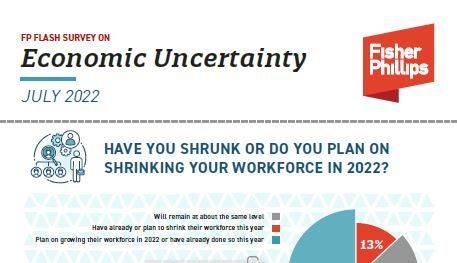FP Flash Survey Reveals: Most Employers Moving Full Speed Ahead Despite Looming Economic Uncertainty
Insights
7.28.22
Despite the swirling economic volatility around the country, more than 40% of employers plan on growing their workforce in 2022 – and one in four businesses will pick up the pace this year and hire more employees than they typically would. Those are just two of the interesting findings revealed by Fisher Phillips’ latest Flash Survey, conducted between July 12-15 and gathering the thoughts of over 625 U.S. employers. You can examine all the details by clicking through here. Not all employers have such a rosy outlook, however, as the survey found that businesses in a few key industries plan on shrinking their workforces or at least slowing the pace of hiring. And many businesses have begun taking tangible steps to tighten their operations in the face of a possible recession – steps that may impact your own business. What do you need to know about what other employers are planning?
Only A Small Number of Employers Will Shrink Their Workforce This Year
Despite concerns of a possible recession and an economic downturn, only 13% of all employers surveyed said they have or plan on shrinking their workforce in 2022.
- Meanwhile, 43% of businesses plan on remaining at about the same level.
- A whopping 44% plan on growing their workforce in 2022 or have already done so this year.
These 3 Industries Are Most Likely to Reduce Their Employee Rosters
There are three industries that are taking a more cautious view on what the rest of the year might bring:
- 30% of Tech companies have or plan to shrink their workforce in 2022
- 25% of Healthcare organizations
- 21% of Retail operations
These 4 Industries Are the Most Gung-Ho
Compare those three industries with the following four, which plan on ramping up and growing their workforce the most robustly in 2022:
- 80% of PEOs
- 53% of Construction outfits
- 50% of Professional Services businesses
- 50% of Transportation operations
Half of Employers Will Continue Hiring Like Usual
50% of the businesses who responded to our survey indicated that they plan to hire at the same pace as usual for the rest of 2022, hoping to ride out the storm of economic uncertainty by deploying the same team for the foreseeable future.
- The other half of employers are split fairly evenly between taking a cautious or an expansive approach.
- 24% plan on slowing hiring for the remainder of the year.
- 26% plan on picking up the pace and increasing hiring for 2022.
No Surprise in Which Industries are Most Ambitious
Given the results from the previous question, it is no surprise to see the three industries that expressed the most confidence about hiring plans for the rest of 2022.
- 44% of Construction outfits will pick up the pace on hiring
- 40% of PEOs (with 27% reporting they will “considerably” increase the pace of hiring)
- 36% of Transportation operations
Little Surprise in Which Industries Are Most Cautious
Similarly, there is little surprise given the responses to the previous question in examining which industries will be taking a cautious approach for the remainder of the year
- 53% of Retail employers will be slowing the pace of hiring for the rest of 2022 (with a quarter of retail businesses surveyed saying they will “considerably” decrease hiring)
- 40% of Automotive businesses
- 30% of Tech companies
Managing Cash Flow Will Be a Popular Tactic for the Rest of the Year
When polled about what steps businesses will take in 2022 in reaction to the swirling economic uncertainty, there are three plans of attack that seemed to resonate the most with our respondents:
- Identifying and eliminating operational inefficiencies: 43%
- Managing cash flow more aggressively: 38%
- Cross-training employees for different roles: 37%
While most organizations are continually striving to identify and wipe out inefficient practices, and cross-training employees is always a tried-and-true tactic to better a company’s operations, there is another popular tactic that could impact you in more ways than one. Nearly 40% of all respondents said they would manage cash flow more aggressively for the rest of the year – which could end up hitting your bottom line if your vendors and other business partners stall typical payments or otherwise alter their accounts payable practices.
Some other common steps employers are seeking to take in 2022 to help offset possible economic woes:
- Using technology to reduce labor costs: 27%
- Reducing office expenses: 26%
We also expect to see the following steps by a smaller number of employers:
- Scaling back department budgets: 16%
- Implementing alternative work schedules: 15%
- Limiting or prohibiting business travel: 14%
- Investing in preventive efforts (handbooks, policies, internal audits, etc.) to reduce possible legal exposure after expected terminations: 12%
- Reducing physical footprint of office space: 10%
Finally, there are three tactics that will largely be ignored by businesses:
- Increasing use of temporary/part-time workers: 8%
- Eliminating operations, plants, offices, departments: 6%
- Cutting wages: 1%
Employers Not Feeling Particularly Empowered
We also wondered whether employers were feeling generally empowered given the anticipated softening of the labor market and a possible rebound in leverage from employees to management – and it appears that we’re not seeing movement in that regard to any large degree. Less than a quarter of employers say they will raise the bar for hiring to ensure only highly qualified workers are brought aboard in 2022, and only 17% say they will more closely scrutinize workers’ performance for the rest of the year. The power still seems to lie firmly in the arms of employees for the time being.
Employers Beginning to Step in to Assist with Inflation
Finally, we polled employers about which proactive steps they are taking to reduce inflationary concerns among their workers. The most common? Raising pay to match cost-of-living expenses, with nearly one in three employers bumping employee compensation. Meanwhile, a quarter of employers are permitting workers to operate remotely to reduce commuting expenses, and about the same number are taking a different route – increasing mental health resources.
- Offering bumps in pay to match cost-of-living increases: 30%
- Permitting employees to work from home to save on expenses: 25%
- Increasing mental health resources: 24%
- Offering financial wellness programs and training: 21%
- Holding town hall meetings or otherwise increasing communication to reduce concern: 19%
- Providing gas subsidies: 10%
- Providing savings matching programs to boost employee savings: 6%
- Offering short-term employee loans: 6%
- Offering subsidies to encourage use of mass transit: 1%
Full Look at the Numbers
Conclusion
We will monitor these developments and provide updates as warranted so make sure that you are subscribed to Fisher Phillips’ Insights to get the most up-to-date information direct to your inbox. If you have further questions, contact your Fisher Phillips attorney or the authors of this Insight.
Related People
-
- Michelle I. Anderson
- Partner
-
- Stephen Scott
- Partner
-
- Hannah Sweiss
- Partner
Service Focus
Industry Focus
- Aviation
- Automotive Dealership
- Healthcare
- PEO Advocacy and Protection
- Retail
- Supply Chain
- Trucking
- Transportation and Supply Chain



